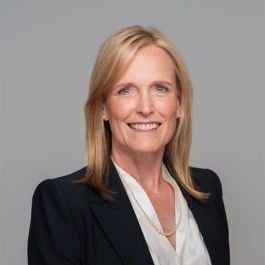Having women in leadership positions is important for more than just equality: It’s actually better for a company’s bottom line — especially in tech.
The Women in Tech Network reported that women statistically outperform men in tech leadership roles. Teams with women at the helm continuously perform better financially, according to a multi-year study from McKinsey.
Women in tech leadership are force multipliers. But what’s their playbook for landing their roles with so many systemic odds stacked against them?
Built In spoke with inspiring women in tech who shared their personal journeys, as well as the mentors and mindsets that helped them succeed.
Imprivata is a cybersecurity company focused on digital identity management.
Describe your career journey so far. What skills and experiences have you acquired along the way that have helped you get to where you are now?
With a foundation in computer science, my early journey began with a curiosity for systems thinking and a pursuit of end-to-end impact. That curiosity found a home in quality engineering and later expanded through experiences in escalation management, Agile enablement, release and delivery leadership and acquisition integrations. Each step revealed new perspectives on how talent and technologies can come together to create innovative, scalable outcomes.
A belief that no task is too big or too small has remained constant throughout. Openness to learning and adaptability have been essential, but my greatest lessons have come from supporting others’ success. In my experience, when you shine the spotlight on others, it naturally reflects on you. My greatest growth has come from helping others achieve theirs — creating environments where teams can adapt quickly, innovate freely and deliver with a purpose.
What support did you receive from individuals or resources that helped you step into a leadership role?
My family has been my foundation from the start. Choosing an engineering discipline as a woman in India in the 1990s — and later pursuing a master’s degree in Boston — wasn’t a common path. Their unconditional support gave me the courage to take those steps and shaped my belief that confidence grows when others place trust in you.
Throughout my career, I’ve been fortunate to have mentors — both men and women — who invested their time and perspective. I approached those opportunities with gratitude and preparation, always mindful of the responsibility that comes with someone else’s belief in you.
At Imprivata, I’ve had access to meaningful resources that helped me grow as a leader, from sponsored leadership programs and boardroom readiness boot camp to the women in technology initiative that empowers women across the organization. Mentoring others in that program has been particularly rewarding — it’s reminded me that leadership is as much about enabling others as it is about evolving yourself.
How do you encourage other women on your team to become leaders themselves? Are there any stories you can share that showcase how you’ve done this?
I encourage women to explore and take on new challenges — whether that’s within their current field or across different disciplines. The path to leadership is rarely a straight line. My advice is simple: Make a bet on yourself. Don’t wait to feel completely “ready” or for someone else to hand you the next opportunity — step forward and claim it. Real growth happens when you put yourself out there and try something new. And most important — bring others along for the journey.
One experience that stands out is my relationship with a senior manager in my current organization who was also my first mentor at this company. Over the years, we’ve grown side by side — learning from each other, challenging each other and celebrating each other’s wins. That mutual trust and shared learning have shaped both of our careers. It’s a reminder that leadership isn’t a solo pursuit; it’s built through collaboration and the willingness to lift others as you climb.
Rula is a mental healthcare tech company.
Describe your career journey so far. What skills and experiences have you acquired along the way that have helped you get to where you are now?
I’ve spent most of my career in startups, drawn to the challenge of building from the ground up. Early on, I focused on establishing go-to-market strategies and scaling teams in fast-moving environments. At one point, I made a deliberate move to a large organization to gain “big company” experience — learning about complex processes, enterprise operations and how to navigate at scale. Ultimately, I recognized that my skills and energy are best applied to zero-to-one motions, identifying opportunities, building teams and putting the right structure in place to drive growth.
That experience taught me that relationships matter as much as strategy. Saying yes opens doors, but knowing when to say no is equally important. I’ve learned to listen, observe and surround myself with people who bring different perspectives — much like Abraham Lincoln’s “team of rivals.” That diversity of thought has been critical in building strong, adaptable teams.
What support did you receive from individuals or resources that helped you step into a leadership role?
Mentorship has been essential and I’ve found that mentors come in all shapes and sizes — not just your manager. Some of my most impactful guidance has come from peers, advisors and even team members who saw things from a different vantage point.
I’ve also learned the importance of asking for help and raising your hand for opportunities. Leaders don’t have to have all the answers, but they do need the humility to seek input and the courage to take risks. Taking a chance on something new — knowing the worst-case scenario is often just a pivot — has propelled my growth more than any single title or role.
How do you encourage other women on your team to become leaders themselves? Are there any stories you can share that showcase how you’ve done this?
I believe leadership starts with creating space for others to step forward. I encourage those on my team to take on visible projects, share their expertise cross-functionally and embrace calculated risks — even when they don’t feel 100 percent ready.
One example that stands out is a team member who was hesitant to lead a major client initiative because she felt she didn’t yet have the “right” experience. By working together to frame the project as a stretch opportunity and supporting her behind the scenes, she not only delivered successfully but also grew into a confident leader for others.
For me, the goal is to help women see that leadership is not about being the smartest person in the room — it’s about listening, learning and building strong relationships that move the ball forward.
Huntress is an enterprise-grade, people-powered cybersecurity company.
Describe your career journey so far. What skills and experiences have you acquired along the way that have helped you get to where you are now?
I had originally started out as a musician, but had always been good with computers. I had taken some programming classes in junior high and had just puttered around with them for fun. When I moved to NYC I eventually decided to study computer science more formally. Eventually I decided to meld my love of true crime and computers and got a master’s degree in computer forensics. Learning how to program was integral to my success, however, since the field of computer forensics was still very new and you would often have to create new tools to parse artifacts (because there wasn’t a tool available) or troubleshoot existing tools that might not work as expected. Also having knowledge of how to program and operating systems internals made my analysis skills better because I knew how programs should operate and how to debug them. This was extremely helpful when trying to reverse engineer malware or writing new code to do RAM forensics.
What support did you receive from individuals or resources that helped you step into a leadership role?
When I was a grad student I was lucky to have stumbled across some research around memory (RAM) forensics, (which led to the Volatility project) and I was able to find one of the authors (Aaron Walters) on IRC (an online chatroom). I was interested in this project because it was a component that I needed in order to finish a research project of my own. Luckily Aaron and others in the chatroom were very receptive and encouraging. It was a wonderful open source community in which I was accepted and flourished. As I got more involved in the project, I took on more and more responsibilities. I had really found my niche.
Being one of the people responsible for updating and maintaining code for the Volatility project definitely helped put me on the trajectory for a leadership role. When working with others on open sourced projects, you can come across all kinds of personality types. There will be times you don’t agree on things, but you have to come to some sort of common ground in order for the project to survive. I was able to take what I learned during there and apply it to my day job in order to manage not only time and projects, but people.
How do you encourage other women on your team to become leaders themselves? Are there any stories you can share that showcase how you’ve done this?
These days I tend to act as a sounding board and mentor for various women co-workers, friends or acquaintances as requested. I try to listen as much as I can when others come for advice. Women in general are not often listened to in their day-to-day lives, often due to bias, so I try to make sure that they feel heard when they are seeking advice on something. It also doesn’t make sense to try to solve a problem for someone, without even fully understanding the problem to begin with. I try to ask open-ended questions so that I’m not probing them towards an answer that I am thinking of before knowing the full scope of the problem.
Recently I had someone who was trying to advance her career, but didn’t feel like people were taking her seriously. The main problem I saw was that upper leadership just didn’t know much about her at all. I gave her advice on how to make herself more visible, but within her comfort zone. She took the advice and it worked- she was promoted within the next promotion cycle. Sometimes it’s not that you’re doing the wrong things, you may just need to tweak what you do, in order to accomplish your goals. Talking to a third party person might help with that.
OpenX is an ad tech company that drives optimal value for advertisers through high-scale marketplaces across all screens.
Describe your career journey so far. What skills and experiences have you acquired along the way that have helped you get to where you are now?
I began my career as an industrial engineer consulting across industries such as manufacturing, banking, healthcare, telecom and travel, where I sold, managed and delivered large-scale process improvement projects. In that work, I learned the importance of starting with the problem statement. Too often, teams rushed to solutions or technology, but the greatest impact came from slowing down to clearly define the issue first. Within a few years I was promoted to supervisor and completed management training that taught me how to give feedback, lead teams and navigate executive settings. One of my biggest growth moments was pitching a transformation to a Fortune 100 executive team. It was intimidating, but it showed me that stepping into uncomfortable rooms is how you grow. Later, when I stepped back into an individual contributor role after burnout, I learned patience, persistence and humility and it grounded me in the challenges of being on the front lines. Today I lead a broad portfolio that includes PMO, operational excellence, content integrity, IT, real estate and office ops and I rely on these early lessons every day. My path reminds me that careers are rarely linear.
What support did you receive from individuals or resources that helped you step into a leadership role?
Early in my career, I believed I had to lead in ways that did not feel authentic. In my organization there were very few female leaders and I tried to emulate the leadership approach I saw modeled, which meant hiding parts of myself that later became my strengths. With the help of a coach, I learned that authenticity builds trust and once I became comfortable being myself, the teams I led grew stronger. I also had a manager who shaped my philosophy. He told me he would keep me six inches underwater, challenged but able to come up for air and that mistakes were expected as long as I learned from them. That guidance gave me courage to stretch. I found it liberating to admit mistakes the moment I recognized them, often walking in with a solution or already having course-corrected. That honesty built his trust in me and showed me that leadership is not about being perfect, but about being accountable, transparent and willing to grow. Looking back, the balance that helped me most was being trusted while still being pushed to grow.
How do you encourage other women on your team to become leaders themselves? Are there any stories you can share that showcase how you’ve done this?
I try to offer the kind of support that gave me the courage to step forward. I tell my team I expect mistakes, but I ask for honesty so I can have their back and help them course-correct. That safety net builds confidence. I also coach women to advocate for themselves with evidence of their impact, not just tenure, when they seek growth opportunities. Early in my career, I gave a stretch assignment to an administrative colleague whose instincts were strong but who lacked the formal engineering degree her peers had. Some doubted her credibility, but she excelled and later became the leader of an engineering group. That experience reinforced for me the importance of looking beyond credentials to recognize potential and create opportunities. For me, leadership has not been linear and I do not believe it has to be. It can be authentic and uniquely your own, especially when you help others find their path as well.
Bounteous is an end-to-end digital transformation consultancy delivering innovative and strategic solutions in strategy, analytics, digital engineering, cloud, data and AI, experience design and marketing.
Describe your career journey so far. What skills and experiences have you acquired along the way that have helped you get to where you are now?
I’m grateful for having had so many varied roles across my career in technology services and having learned from an incredible set of mentors along the way. With the full benefit of hindsight, there are three types of roles that each helped develop a different aspect of my leadership style and career path. The first are the roles where I have had the opportunity to set the strategy of a business and then execute against that plan. The second set of roles were where I was learning something entirely new and building a fund of knowledge around it. And the third and an element I look for in every role, is having the privilege to develop and lead people. The best roles have a combination of two or three of these attributes. My biggest advice in choosing any role is making sure you believe you can have an impact and that it’s something you can see yourself really enjoying each day. There is no such thing as a straight-line career path. Instead, it’s a series of experiences that you string together and hopefully, you can look backwards and like the story that you see.
What support did you receive from individuals or resources that helped you step into a leadership role?
The advice I would give on support is that you first need to be your own best champion. That means showing up in your current role in your best way possible, even when no one is looking. It means helping other colleagues in their day-to-day roles without an expectation that there’s a payback coming to you. And it means focusing on how you can help the leaders around you achieve their goals as opposed to asking how they can help you. This may seem contrary to championing your career but the best opportunities show up when you’re busy being your own great self. That said, everyone should build a core group of people from your professional life that are your trusted advisors. These are the people that you go to for help and advice. Cultivate these relationships carefully and they’ll become your pack throughout your career.
How do you encourage other women on your team to become leaders themselves? Are there any stories you can share that showcase how you’ve done this?
My biggest advice to women as they advance in their careers is that ‘having it all’ is not a thing. It’s a series of compromises and gear shifts between priorities. Each person’s sense of balance comes from a different mix of those priorities. When the mix gets off a bit, it’s up to you to navigate yourself back to the right balance. Neither your boss nor your teammates are going to do that for you. I’ve also always appreciated the analogy that we are each juggling a series of balls. Some of these balls are glass and some are rubber. Keep your focus on not breaking the glass ones because all the other ones can be picked up again at the right time. Growing as a leader becomes much easier once you find your rhythm in taking care of yourself and your personal priorities.
Alliant Credit Union’s mission is to disrupt banking norms to do good for members, employees and communities.
Describe your career journey so far. What skills and experiences have you acquired along the way that have helped you get to where you are now?
From an early age, I was deeply intrigued by the potential of high-quality, trusted data in shaping business decisions. I began my career in information technology, working in various data management roles.
To deepen my understanding of business challenges related to data and processes, I transitioned to the business side, where I led cross-functional initiatives focused on improving data quality. Through this experience, I naturally gravitated toward the discipline of data governance, recognizing it as the foundation upon which data quality, master data management and risk management initiatives succeed.
I developed a strong passion for data governance and have since focused on establishing robust frameworks and practices in areas such as data ownership, metadata management, data lineage, data quality, data controls and data issue governance. Along the way, I also discovered a passion for leadership and have held several data leadership roles.
I’ve successfully driven numerous cross-functional data programs across the banking, high-tech and healthcare sectors. These cumulative experiences ultimately led me to my current role as director of data at Alliant Credit Union.
What support did you receive from individuals or resources that helped you step into a leadership role?
My growth mindset, commitment to continuous learning and willingness to take calculated risks have been key drivers in preparing me to embrace new challenges and advance into leadership roles with each career move. I proactively invested in my development by reading leadership books and articles, earning certifications and networking with industry leaders and peers. I also actively contribute to professional organizations and thought leadership initiatives. I serve as an executive editorial board member of CDO Magazine and as a governing body member of the Evanta/Gartner CDAO group.
I consider myself fortunate to have worked with exceptional managers who also served as mentors. They played a pivotal role in shaping my career and bringing out the best in me. They believed in my potential and helped me recognize strengths — such as empathy and kindness — that I had previously overlooked. Their influence helped me understand my own value and the unique contributions I bring to the table.
They taught me that leadership isn’t about authority — it’s about serving your team. People thrive when they are trusted, appreciated, recognized and given the resources and support they need to succeed.
How do you encourage other women on your team to become leaders themselves? Are there any stories you can share that showcase how you’ve done this?
Fostering a culture of diversity, equity, inclusion and collaboration is one of my core leadership principles. I emphasize the importance of creating an open, psychologically safe environment where everyone feels valued, respected and empowered to contribute.
I firmly believe that leadership is not tied to a title — anyone can be a leader by taking ownership, being accountable and driving a task or initiative to completion. I often mentor women team members by encouraging them to step forward and lead cross-functional initiatives or take charge of specific challenges. I’ve seen quiet, thoughtful team members rise to the occasion and lead with impact, gaining recognition and confidence in the process.
Personally, I used to believe that leaders are born leaders and a softspoken, quiet, kind and empathetic person cannot be a good leader. But through experience, I’ve come to understand that leadership is a skill — one that can be developed with intention and effort.
I share my own journey to help women see that they, too, can be leaders. I encourage them to believe in their abilities and lead by example — because when one woman rises, she inspires many others to do the same.
Whatnot leverages live streaming to connect buyers and sellers in the collectibles marketplace.
Describe your career journey so far. What skills and experiences have you acquired along the way that have helped you get to where you are now?
My career has been anything but linear — I have spent the last 13 years choosing industries and companies that are interesting to me and then finding my place in them. Litigation consulting was where I started my career, giving me really great structure and a depth of experience in having to become an expert in topics I do not know much about. That carried over in an incredible way to the world of tech, which I have now been a part of for the last 10 years. I have split the last 10 years across three amazing companies: Box, Faire, and now, Whatnot. Box was my gateway to understand how great SaaS companies are built and why passionate leaders matter (Aaron Levie will forever stand out as a world-class CEO). Faire was where I grew up as a professional — I earned opportunities to take on big bodies of work, I made mistakes, I iterated on those mistakes and I learned that having the right people around you during all of that makes a world of difference (always choose opportunities where you can lift others and they can lift you). At Whatnot, I have had the opportunity to blend the best parts of my career so far into one, merging great leaders, a clear mission and a world class team.
What support did you receive from individuals or resources that helped you step into a leadership role?
I would say a key set of peers and mentors have been my biggest assets in shaping my own leadership style. I have been extremely lucky to be surrounded by intelligent and thoughtful peers throughout my career that have helped be a sounding board and a grounding resource for me. When I have felt overwhelmed or out of my own depth, I have been able to go to three key women in my life (Olivia Chen, Roxie Rum and Victoria Nelson) that helped give me direction and instill confidence in who I am and can become as a leader. I have also found amazing women mentors in women like Jennifer Burke and Katie Leighton, women I have had the opportunity to work with for the past 10 years. They have heard me out when I am feeling lost and spoken hard truths to me when I need a snap back into reality. Most importantly, all of these women have shown up in their own careers with confidence and vulnerability that I aspire to have. Watching them in their roles and being able to go to them for help without judgement has been key in creating a foundation for my own leadership style.
How do you encourage other women on your team to become leaders themselves? Are there any stories you can share that showcase how you’ve done this?
I try to do this through action and vulnerability. I show up everyday as the leader that I would want to see for myself and I am honest with myself and my team when I feel like I am missing that bar. When starting in my current role, I focused on showing up as a leader by getting into the weeds of the work that my team was driving. I did not just want to hear high level how things were going, I wanted to meet them where they were doing their work, understand the why behind the work and give perspective on how I think that work could evolve. This allowed me to be effective with my team quickly and establish credibility that I am not just trying to talk the talk but walk the walk. On the point of vulnerability, I make it a point to highlight the power of harnessing your emotion to make you a more in touch and effective leader. I have had many instances where women have come to me saying “I am just feeling emotional” to dismiss a feeling of overwhelm or discontent. My response is usually the same: “Your emotion shows me you care.” Then we focus on how they can channel that care to find a better way of working.
FourKites eliminates supply chain silos with integrated AI that turns real-time data into autonomous action.
Describe your career journey so far. What skills and experiences have you acquired along the way that have helped you get to where you are now?
I’ve always been in B2B tech marketing, mostly in SaaS. What started as an internship became my first role as a marketing copywriter for a mid-size ERP company. My wonderful leaders and mentors gave me opportunities to shine, including owning our customer newsletter, collaborating on our 10K and even traveling for my first international business trip to facilitate customer testimonials. Those five years gave me the confidence to take a role in solutions marketing/demand generation by day and an executive mba program in marketing and supply chain by night. I spent the next 15 years building my GTM and leadership muscles as I grew to become team lead and eventually senior director of demand generation and account-based marketing.
I’ve always viewed myself and been told I’m a natural leader. As I’ve progressed, leadership and the people aspect of the job stood out — I learned a lot from my tremendous leaders. I always knew who and what I wanted to be and they shaped me into exactly that, a vice president of marketing at a supply chain tech company. I love my job and feel fortunate to do what I do every day. I hope to give my team and future marketing leaders the same guidance and opportunities.
What support did you receive from individuals or resources that helped you step into a leadership role?
The leaders who have stood out most to me and helped shape who I am as a leader are those with whom I formed a bond. It wasn’t always just business. They expected stellar results and a high degree of accountability. And, they recognized that at the end of the day, we are all people with a common business goal, who happen to spend a lot of time together so we might as well enjoy it. The best leaders I’ve had had my back, were transparent, pushed me, believed in me, got to know me and helped clear the way for me to succeed.
I think it’s so important not to shelter your team or your leaders. Give them visibility and opportunities to do what they do best. Let them earn the recognition for their good work. Never take credit for what they’ve done. Always cheer them on and celebrate their successes, publicly. As leaders, we are here to inspire, to provide guardrails and a framework. We have years of experience to rely on and to teach our teams what’s possible when they believe in themselves and their own abilities.
How do you encourage other women on your team to become leaders themselves? Are there any stories you can share that showcase how you’ve done this?
Arguably, there are more women leaders in marketing than in other departments. But still less, in general, especially in tech. I encourage the women on my team to use their voices and expertise and be bold — frankly, I encourage men to do the same. I’ve been fortunate to promote women to leadership roles and sometimes asking them if it’s what they want is the right first step. I believe in open dialogue. I am an open book. And I’ve maintained relationships with those I’ve helped grow, just as I remain connected to those who came before and inspired me.
My leadership style is largely based on two ideas. The first is radical candor, a book and a practice that implores leaders to challenge directly and care personally. This resonates because it’s always personal, even when it’s business — when people know you truly care, direct feedback can be better received. Secondly, you cannot be an expert in everything, especially as you gain more responsibility. Your own leadership team is crucial to your success and the entire function. Rely on your leaders. Learn from them (never stop learning). Because, as they say, all boats rise and it’s more rewarding for everyone this way.
Clear Street is a financial technology firm on a mission to modernize the brokerage ecosystem.
Describe your career journey so far. What skills and experiences have you acquired along the way that have helped you get to where you are now?
I’m currently Managing Director, Program Management at Clear Street but my career began 28 years ago at Morgan Stanley as a software engineer, where my first five years were spent sharpening technical skills, writing clean code and designing reliable systems. But I was never satisfied with just knowing how to build. I was curious about why. That curiosity drew me into design and business discussions, soon leading me to own projects end-to-end.
That perspective opened the door to leadership. I grew from leading teams of five, to 10, to 20 and eventually 300 engineers globally. I learned leadership wasn’t about directing people, but creating opportunities for them to grow. I often handed off stretch assignments or parts of my role so others could take ownership which helped them develop and freed me for new challenges.
When I transitioned to a startup, I leveraged my strengths — organization, curiosity and program management — to drive Clear Street’s growth. Though my team is small, my impact is company-wide. I focus on responsibility, learning and results, approaching challenges as stepping stones with grit and curiosity.
What support did you receive from individuals or resources that helped you step into a leadership role?
The most valuable support I’ve received throughout my career has been trust. I earned it by making integrity my foundation, by being transparent with both successes and failures and always explaining the reasoning behind my decisions. That consistency gave my managers confidence in me, even in uncertain situations.
One defining moment came early on when a system I owned failed during a critical release. Instead of hiding the issue, I immediately called my manager, explained what went wrong and laid out options to fix it. That honesty didn’t cost me credibility — it built it. From then on, I was trusted to take on larger responsibilities.
Support didn’t always come in the form of formal mentors; it came from managers who gave me room to make decisions, peers who collaborated and teams who followed because they believed in me. Trust, once built, became the strongest resource in helping me step confidently into leadership.
How do you encourage other women on your team to become leaders themselves? Are there any stories you can share that showcase how you’ve done this?
I believe leadership isn’t tied to titles. It’s built through authenticity, curiosity and courage. I encourage women on my team to see themselves as leaders early, by asking questions, speaking up and taking ownership. I remind them that challenges are not roadblocks but opportunities to create impact.
One example is a teammate who was frustrated by repetitive, manual tasks. Instead of accepting them, I encouraged her to automate the process. At first she hesitated, since it wasn’t in her comfort zone, but she took the challenge and built a solution that eliminated the work. That project not only saved time but positioned her as a leader in automation across the team.
Moments like this prove that leadership grows when people are trusted to stretch themselves. By giving women confidence, support and opportunities, I help them discover the leaders within themselves.
Navan is a corporate travel and expense software company that makes travel and expense easy.
Describe your career journey so far. What skills and experiences have you acquired along the way that have helped you get to where you are now?
My career journey has been super dynamic. I began in the hospitality sector, where I spent four years managing a hotel and leading a team of 30 people. “Resilience” is the first word that comes to mind; the hospitality industry demands hard work, long hours and strong emotional intelligence. This experience taught me how to adapt swiftly to all kinds of situations and maintain perspective under pressure.
When transitioning into tech leadership, I brought those lessons with me. The main principle remains: always treat people how you would want to be treated. It is crucial to lead by example, set transparent expectations for your team and yourself and commit to continuous learning.
What support did you receive from individuals or resources that helped you step into a leadership role?
Stepping into leadership in tech was a significant — and initially uncomfortable — move. My first manager, Jeremy Schneeweiss, played a truly crucial role, providing the right guidance and honest feedback. He helped me recognize my own potential and fully supported me in taking the lead.
In addition, having colleagues who championed my growth and encouraged me to take smart risks gave me the foundational confidence needed to lead with authenticity and resilience.
How do you encourage other women on your team to become leaders themselves? Are there any stories you can share that showcase how you’ve done this?
I would give this advice to men and women: If leadership is a path you want to take, surround yourself with people who are already leaders in their roles. Project yourself in that role and take ownership of tasks as you would in that role.
Work hard, work harder than everybody else, set the bar high and take every opportunity you can — constantly challenge yourself. That’s how you learn. You may or not be the only woman in the room, but that’s okay. Focus on what you bring to the table.
Regal is an AI platform that empowers companies to transform customer communications with AI agents.
Describe your career journey so far. What skills and experiences have you acquired along the way that have helped you get to where you are now?
I found my passion for sales at my first internship, at a restaurant tech startup. Since it was a startup, I was able to wear many hats working across finance, marketing and sales. I was also fortunate to report directly to a female executive who became an early role model and mentor of mine. She was an extraordinary leader whose confidence and authenticity inspired me to pursue sales and shaped the leader I wanted to become.
After college, I joined Regal as a BDR. It was challenging but invaluable, as I learned resilience, competitiveness and organization from talented AEs and peers. Those skills helped me step into the BDR team lead role, balancing my own quota while managing a team. The experience sharpened my time management skills and gave me my first real foundation in leadership.
Now, as a BDR manager, I’m building on those foundations. Growing daily in communication, leadership and balancing being a peer and a manager. One of the most rewarding aspects of my role is mentoring my team, just as others once mentored me. All of these have been formative in shaping the leader I’m becoming today.
What support did you receive from individuals or resources that helped you step into a leadership role?
One of my most significant sources of support has been Regal itself. With “Growth Mindset” as a core value, we invest in employees through a stipend I used for leadership coaching and one-on-one development. I was given structured tools and feedback that built my confidence as I transitioned into leadership.
Equally important have been the people around me. I’ve been fortunate to work with generous colleagues, including those who held my role before, who shared their experiences and helped me navigate new challenges while modeling what strong leadership looks like.
I can’t overstate the impact of my managers. They’ve encouraged me to ask questions, lean on them when I hit roadblocks and approach new situations with curiosity over fear. Their support created a safety net, showing me I didn’t need all the answers on day one and could always bounce ideas off them. The mix of formal resources and personal mentorship has been essential in shaping the leader I’m becoming.
How do you encourage other women on your team to become leaders themselves? Are there any stories you can share that showcase how you’ve done this?
A critical part of my role is helping women on my team recognize their strengths and giving them the confidence and opportunities to lean into them. Often, this means encouraging them to take risks, whether it’s raising a hand for a promotion, stepping into new responsibilities or trying something outside their comfort zone. Sometimes, simply saying, “you’re really good at this and ready for more,” can shift how they see themselves.
I often give team members the chance to present to the broader BDR group, recognizing their expertise and allowing them to step into an educational and leadership role. The spotlight can be motivating and I’ve seen it inspire people to take on bigger challenges.
Beyond those moments, I celebrate wins out loud, with constant shoutouts to ensure their work is seen. Supporting women is critical in a male-dominated space like sales because representation matters. For me, leadership isn’t just about hitting numbers; it’s about making people feel supported, confident and ready for what’s next.
Ro is a direct-to-patient healthcare company with a mission of helping patients manage their care journey.
Describe your career journey so far. What skills and experiences have you acquired along the way that have helped you get to where you are now?
Although the past eight years of my career have focused on consumer health tech, I didn’t start in tech or healthcare. I began in management consulting at Bain and later in strategy at PepsiCo, where I discovered how much I love building and shaping consumer businesses. That led me to Warby Parker, where I got my first real taste of consumer tech and realized how much I thrive in customer-obsessed, fast-paced environments. After business school, I transitioned into product management at a fitness startup, where I built technical fluency — but I found many of the skills I’d developed still applied: structured problem solving, strategic thinking, analytics and a deep focus on the customer.
At Ro, I joined as the first product hire and built the team from the ground up — often balancing IC work with team building. The skills that have carried me forward most are the ones that scale, breaking down complex problems, identifying key levers and coaching others to do the same. Pair that with strong collaboration, storytelling and a clear vision and you can turn good ideas into great impact. Those are the foundations that have guided me at every stage of my career.
What support did you receive from individuals or resources that helped you step into a leadership role?
One of the most meaningful forms of support I received early on was honest, unfiltered feedback. A mentor once told me, “You’re coming across more junior than you are.” It stung — but it was a turning point. I realized leadership isn’t just about what you do, but how you do it. How you present ideas, how you recruit beyond your comfort zone, how you show up with solutions — all of it shapes how others perceive your leadership. My best advice: actively seek raw feedback on your tone, rigor and presence — even when it’s uncomfortable.
Role models also shaped me. From every peer and manager, I learned what to emulate and what not to. Often the best lessons came from watching what didn’t work.
I also tried to think at the next level before I was there — imagining how I’d set priorities or navigate tradeoffs in my manager’s shoes, all while still crushing my current role. Dropping the ball in your current role is one of the fastest ways to lose credibility.
And while it might sound cliché, leadership books helped. I used my commute to listen to favorites like “Turn the Ship Around” and “The Five Dysfunctions of a Team” — they gave me language and models I could use right away.
How do you encourage other women on your team to become leaders themselves? Are there any stories you can share that showcase how you’ve done this?
One of the most important things I can do as a leader is give women on my team room to run. I’ll get into the weeds with them when needed — offering feedback on their work or communication — but ultimately, I want them in front of other leaders, stretching into the next level of visibility and impact.
One area I coach on frequently is how to make ideas land with senior stakeholders. It’s not enough to present the work — you need to provide the right context. I often ask: What do you need others to know before they can engage with this? What questions or doubts might they already have walking into the room? How can you proactively address those? This helps them communicate with clarity and conviction, rather than watering down their message.
I’m also fortunate to work alongside an incredible group of women leaders at Ro. They’ve shown me every day that there isn’t a single mold for leadership and that there are many authentic ways to lead. That example of diversity in leadership style is powerful and I try to reinforce that message with my own team — you don’t have to change who you are to be effective. Be authentic, lean into your strengths and keep leveling up.
Dandy is a dental tech company that’s building custom, end-to-end, precision software and manufacturing from the ground up to provide high-quality, consistent and affordable restorations to doctors and their patients.
Describe your career journey so far. What skills and experiences have you acquired along the way that have helped you get to where you are now?
I started my career in data at a Fortune 500 company, but quickly realized I wanted to do more than analyze numbers — I wanted to act on them. That shift led me into product management and then into the fast-paced world of startups, where I’ve built teams, partnerships and processes from the ground up.
Now at Dandy, I’ve worked across go-to-market, operations and product. Each chapter built on the last. Data taught me precision, operations taught me resilience and product keeps me focused on impact. To truly own a product, you have to understand it inside and out — talk to customers, use it yourself and get your hands dirty.
What support did you receive from individuals or resources that helped you step into a leadership role?
I’ve been fortunate to work with mentors who modeled clear, decisive leadership and managers who trusted me with messy, high-impact projects. They pushed me to articulate why something mattered, not just what to do. Along the way, peers offered the kind of honest feedback — calling out blind spots and reinforcing strengths I hadn’t recognized — that helped me grow faster than any formal training ever could.
It wasn’t one big moment that made me a leader — it was a series of small ones where someone said, “I trust you to figure this out.”
How do you encourage other women on your team to become leaders themselves? Are there any stories you can share that showcase how you’ve done this?
For me, leadership isn’t something you earn later — it’s something you practice now. I try to help women on my team see that they’re already leading when they take initiative, give feedback or make decisions that raise the bar for quality.
One story that stands out: A designer on my team used to hesitate to speak up in cross-functional meetings, even when her perspective was exactly what was missing. We worked on how to frame her insights with context and confidence and I made a point to highlight her contributions publicly. Within a few months, she was leading those same discussions, mentoring others and shaping our design standards in the process.
Moments like that are what leadership is about for me — helping people see their own capability before they fully believe it themselves.
The Heico Companies is the parent holding company for a diverse portfolio of manufacturing, construction, and industrial services businesses.
Describe your career journey so far. What skills and/or experiences have you acquired along the way that have helped you get to where you are now?
My career in technology has been shaped by a diverse set of experiences — from starting out as a programmer to leading as a chief information security officer. Along the way, I’ve developed and relied on a few core strengths: resilience, a commitment to lifelong learning, and a proactive approach to embracing new challenges and responsibilities. One pivotal moment in my journey was when I transitioned from a purely technical role into leadership. I took on a position that required not only technical depth but also strategic vision and cross-functional collaboration, leading teams. It was a leap, but it taught me the importance of adaptability and communication — skills that have been essential in every role since. I’ve consistently sought out opportunities that pushed me beyond my comfort zone, and I’ve remained open and intentional about my career goals. That mindset has helped me grow not only in technical expertise but also in leadership, strategic thinking and the ability to build strong, collaborative teams.
What support did you receive from individuals or resources that helped you step into a leadership role?
Stepping into various leadership roles was made possible through the support of mentors, managers, and peers who believed in my potential. Their trust in me was both empowering and motivating — I was committed to honoring that trust and delivering results. I’ve been fortunate to work with leaders who not only provided guidance but also created space for growth, offering constructive feedback, advocating for my development and entrusting me with complex, high-impact responsibilities.
Beyond individual support, I’ve leaned on professional development resources such as leadership training programs, industry communities, and certifications that helped me build both confidence and capability by investing in continuous learning to stay ahead in a rapidly evolving field. One of the most transformative experiences was completing the SIM Regional Leadership Forum program. The program challenged me to reflect deeply on my values and grow as an authentic leader. It provided a unique environment for introspection, connection, and leadership development that continues to influence how I lead today.
How do you encourage other women on your team to become leaders themselves? Are there any stories you can share that showcase how you’ve done this?
Supporting women in leadership starts with building a culture of trust and encouragement. I look for ways to recognize potential and offer opportunities that help build confidence — whether through mentorship, stretch assignments or simple encouragement. One example that stands out is a colleague from another team who was unsure about pursuing a leadership role. Through regular mentoring conversations, I helped her identify strengths and connected her with development resources. She eventually stepped into a leadership role and now supports others in their growth — a great example of how encouragement and support can lead to lasting impact. I also had the honor of being selected by the American Heart Association to represent the IT sector under STEM, speaking to women and students about careers in technology and leadership. That experience reminded me how important visibility and representation are. When women see someone like them in leadership, it helps them imagine their own path forward.
Cohere Health is a healthtech company that provides intelligent prior authorization. The company’s primary goal is to align physicians and payers on the patient’s entire care journey.
Describe your career journey so far. What skills and/or experiences have you acquired along the way that have helped you get to where you are now?
I’ve been fortunate to build a career around what I love — numbers, patterns and to apply them in solving complex business challenges. Whether as a management consultant, an analyst or a leader of analytics teams, I recognized early on the power of data to drive meaningful business solutions.
Over the past two decades, I’ve worked to challenge convention and redefine what’s possible. Along the way, I’ve strengthened my analytics, strategy and leadership skills — but more importantly, I learned the importance of teamwork, trust and partnership. I still remember my first manager staying late with us early-career analysts to ensure we had the support we needed to succeed. That experience shaped how I lead today: cultivating trusted partnerships across my team, the broader organization and clients. As my career has evolved, I’ve taken on leadership roles focused on developing and deploying data-driven solutions across care management, risk adjustment and payment integrity. Through it all, my true north star has been building a culture grounded in trust, empathy and team spirit — values that continue to guide every step of my professional journey.
What support did you receive from individuals or resources that helped you step into a leadership role?
Our experiences — especially the people we work with — have such a significant influence on our careers. I’ve been lucky to have had amazing managers who not only gave me great opportunities but also mentored and guided me to become the best version of myself.
I also benefited from taking on increasingly challenging roles. While the risks were higher, the rewards were greater–exposure to a cross-functional team that allowed me to refine my people skills, collaborate with internal and external partners and, most importantly, build trust. Equally important were all the peers and colleagues who pushed me to think differently and offered honest feedback, helping me grow into a leadership role.
The best way I can honor all those who invested in me is to pay it forward by mentoring others, creating opportunities and developing the next generation of leaders.
How do you encourage other women on your team to become leaders themselves? Are there any stories you can share that showcase how you’ve done this?
I do my best to ensure women on my team have ample opportunities to step into leadership roles. I recognize their strengths, challenge them with new responsibilities and provide guidance when needed while letting them make decisions and learn from their experiences. A testament to that is that women now make up 68 percent of my leadership team.
I firmly believe that ability is not defined by gender. I come from a progressive family that always told me I could do anything I set my mind to. Yet when I entered the workforce, I quickly realized that women were not encouraged to be on the shop floor in manufacturing. At the time, I didn’t even know what a “glass ceiling” was and I worked on carving out an alternate career path. Experiencing those barriers firsthand has fueled my passion for empowering women to take on leadership roles.
One standout example is when a team member returned from maternity leave and shared that we made it easy for her to envision a career path with us while caring for her growing family. It was a moment of immense pride and joy for me.
Being a part of Cohere Health is equally meaningful for me, as diversity, equity and inclusion are central to our culture. Our executive team is 58 percent women and one of our first investors was a woman-founded venture fund. These milestones reflect our values and the impact of intentional leadership and inclusive practices.

































